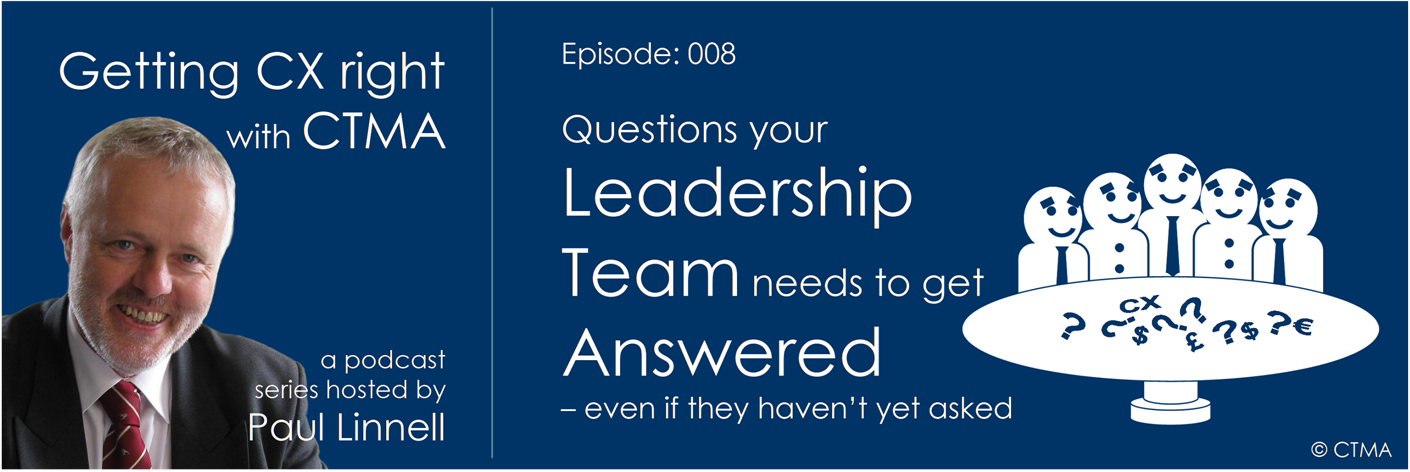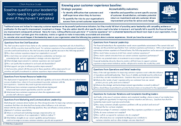Questions your Leadership Team needs to get Answered
- even if they haven’t yet asked
By Paul Linnell
Many big businesses and public services today have adopted an
approach to customer feedback and measurement that only produces a
proxy
performance score that’s hard to translate into dollars, and often
fails to identify what went well and where things went wrong with
customer experience.
You know the scene - someone will ask “What’s the score?”
Then someone else will announce that it’s “28”, or
“82%”, or “93”. Then
everyone checks to see if it’s higher or lower than last month, and then
they all move on.
No wonder they find it hard to take actions to make sure the
good things keep happening and the bad things stop.
If “customer experience” and “ways to improve it” isn’t a scheduled
leadership and board-room topic in your organisation, it may be because
it hasn’t yet been given the vocabulary, metrics or agenda to make it
measurable, accountable and actionable.
What you’ll learn in this episode:
In this episode I want to close that gap by offering a set of
baseline questions your leadership team needs to get answered –
even if
they haven’t yet asked!
And indeed, if you are a member of the
leadership team, these are the key customer experience questions you
should be asking.
The answers to these questions will
empower your leadership team to give your customer experience
improvement programme the energy and support it
deserves.
Also mentioned in this episode
Next Episode: #009: The Four Alternate Realities of the Corporate-Customer Universe
 During the global health crisis, customer service
functions needed to duck and weave to keep their
organisations afloat. In record time, they had to
change their operating procedures, adopt new
practices and new technologies, and many moving to
remote working. There just wasn’t time to go
through a lengthy business justification and an ROI
calculation.
During the global health crisis, customer service
functions needed to duck and weave to keep their
organisations afloat. In record time, they had to
change their operating procedures, adopt new
practices and new technologies, and many moving to
remote working. There just wasn’t time to go
through a lengthy business justification and an ROI
calculation.
But now, as the world slowly returns to normal,
many organisations have moved on to what they see as
a new crisis of change. It’s one driven by a cascade
of issues like increased prices, limited finance and
resources, and problems of shipping and supply. But
there’s a risk, that the customer is now being
missed out of the equation and customer experience
professionals need to rebuild the rigour of disciplines
and frameworks to describe and justify where
customer experience investment is needed to support
this, and future crises of change.
In this episode I describe one of the diagnostic frameworks we use in our
customer experience transformation programmes to provide some insight into the
dynamics at play that undermine value, add unnecessary costs, and the
steps you need to take to tune your organisation for success.
About Paul Linnell
 Paul Linnell is a customer experience and service quality
improvement champion, working internationally with senior managers
and their teams to help them achieve business success, reduce risk
and build customer loyalty and advocacy by taking actions to improve
customer experiences. Paul specialises in the design and deployment
of customer experience measurement, service quality improvement,
complaints handling and preventive analysis programmes. Industries
he has worked with include, Automotive, Consumer electronics,
Consumer goods, Electricity & Gas retail, Financial services,
Information technology, Local Government and Public Sector, Media /
Publishing, Passenger travel (Rail, Air and Sea), Pharmaceuticals
and Telecommunication. Paul has worked with clients and presented on
these subject at conferences and corporate events in the UK, Europe,
North America, the Middle East, Australia and New Zealand.
Originally from the UK and now based in New Zealand, he continues to
serve clients globally.
Paul Linnell is a customer experience and service quality
improvement champion, working internationally with senior managers
and their teams to help them achieve business success, reduce risk
and build customer loyalty and advocacy by taking actions to improve
customer experiences. Paul specialises in the design and deployment
of customer experience measurement, service quality improvement,
complaints handling and preventive analysis programmes. Industries
he has worked with include, Automotive, Consumer electronics,
Consumer goods, Electricity & Gas retail, Financial services,
Information technology, Local Government and Public Sector, Media /
Publishing, Passenger travel (Rail, Air and Sea), Pharmaceuticals
and Telecommunication. Paul has worked with clients and presented on
these subject at conferences and corporate events in the UK, Europe,
North America, the Middle East, Australia and New Zealand.
Originally from the UK and now based in New Zealand, he continues to
serve clients globally.




 Paul Linnell is a customer experience and service quality
improvement champion, working internationally with senior managers
and their teams to help them achieve business success, reduce risk
and build customer loyalty and advocacy by taking actions to improve
customer experiences. Paul specialises in the design and deployment
of customer experience measurement, service quality improvement,
complaints handling and preventive analysis programmes. Industries
he has worked with include, Automotive, Consumer electronics,
Consumer goods, Electricity & Gas retail, Financial services,
Information technology, Local Government and Public Sector, Media /
Publishing, Passenger travel (Rail, Air and Sea), Pharmaceuticals
and Telecommunication. Paul has worked with clients and presented on
these subject at conferences and corporate events in the UK, Europe,
North America, the Middle East, Australia and New Zealand.
Originally from the UK and now based in New Zealand, he continues to
serve clients globally.
Paul Linnell is a customer experience and service quality
improvement champion, working internationally with senior managers
and their teams to help them achieve business success, reduce risk
and build customer loyalty and advocacy by taking actions to improve
customer experiences. Paul specialises in the design and deployment
of customer experience measurement, service quality improvement,
complaints handling and preventive analysis programmes. Industries
he has worked with include, Automotive, Consumer electronics,
Consumer goods, Electricity & Gas retail, Financial services,
Information technology, Local Government and Public Sector, Media /
Publishing, Passenger travel (Rail, Air and Sea), Pharmaceuticals
and Telecommunication. Paul has worked with clients and presented on
these subject at conferences and corporate events in the UK, Europe,
North America, the Middle East, Australia and New Zealand.
Originally from the UK and now based in New Zealand, he continues to
serve clients globally.